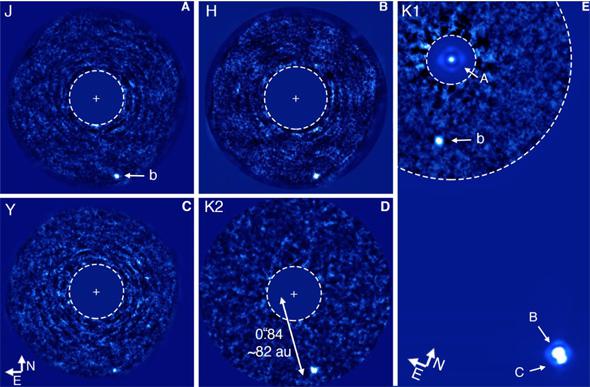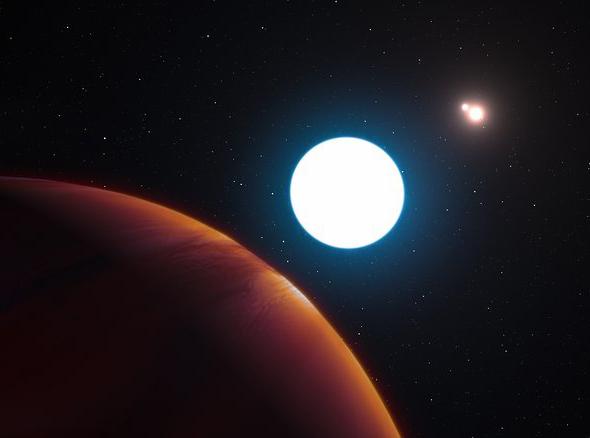Astronomers have discovered a truly remarkable planet. Called HD 131399Ab,* it’s in a triple-star system: It orbits a star orbited by another binary pair of stars!
I know, I know: Pics or it didn’t happen, right?
Yeah, well, here you go:

Wagner, et al., from the paper
Yes, those are actual images of the planet! The frames A-D show the planet (labeled “b”) at different infrared wavelengths, with the primary star’s position marked by a crosshair (the star’s light has been removed using various observational and processing techniques to better see the planet), and the larger panel E is a composite showing the star, the planet, and the binary.
There’s a lot of very cool stuff going on here, so let me explain.
As a whole, the star system is called HD 131399, and it’s what’s called a hierarchical triple: Two stars orbiting each other in a binary pair, which in turn orbits another star. The primary, most massive star is called HD 131399A, and is hotter and more massive (about 1.8 times more) than the Sun. The binary is composed of a star very much like the Sun and another star that’s cooler, redder, and less massive (0.6 times the Sun’s mass). The binary is pretty far out, orbiting the primary at a distance of about 40–60 billion kilometers. That’s about 10 times Pluto’s distance from the Sun, to give you a sense of scale.
The system is part of a loose cluster of stars called an association located roughly 300 light-years from Earth. This is important: We know, from studying those stars, that the association is young, probably around 16 million years old. Why is that important? Because when planets first form they are very hot, and it takes a long time for them to cool. The more massive a planet is, the longer it takes.
The light given off by a hot planet depends on its temperature, and as I said that depends on its mass and age. We know the age, so by examining the light from the planet, its mass can be derived. In this case, the astronomers found the planet has a mass of about four times that of Jupiter! While that’s big, it’s very firmly in the planetary mass range (even if the planet is older, and therefore more massive, it’s still very likely to be a planet and not a low-mass star or brown dwarf).

Wagner, et al.
So how do they know it’s actually orbiting the primary star, and not a background object? I love this part: The astronomers used archived images taken over many years to measure the actual motion (what we call the proper motion) of the system. All the stars in the sky are orbiting the center of the galaxy, but that motion is hard to measure directly because stars are so far away. But some stars are close enough to us that it can be detected (it’s like driving down a road; nearby trees seem to zip past, but a distant mountain appears to pass much more slowly).
By mapping the motion of the stars and the planet, they found that the planet appears to move along with the stars across the sky, showing pretty conclusively it’s actually a member of the system. However, the motion isn’t exactly the same, and that’s because the planet is orbiting the star, and that motion is seen on top of its velocity through space!
Although it’s hard to determine the exact orbital shape and distance, it’s likely the planet is about 12 billion km from the star, and takes about 550 years to orbit it once. Even though it’s more than twice as far from the star as Pluto is from the Sun, its temperature is 575°C (1070°F), still very hot from its formation.
This makes it unique among planets seen so far: It has the widest known orbit for an exoplanet in a triple system. In fact, its orbit is so wide that it’s quite possible the gravity from the binary yanks on it. Over time, the orbit may be unstable! The astronomers ran some simulations and showed it’s about as likely the planet’s on a stable orbit as not. It’s so young that we may be seeing it before it gets ejected from the system … or it may be fine and dandy where it is for the next few hundred million years. Here’s a video animation showing what all those orbits look like:
And there’s more: As far as we know, it’s not possible to form a big planet on such a wide orbit in situ. It’s far more likely it formed much closer in, but an interaction with another massive planet (one too close to the primary to be spotted yet) flung it out to its current distant position. But there’s another possibility, which I find completely fascinating: It may have formed as a planet around the binary stars, and got flung out (either by the stars themselves or another possible planet orbiting them) to its present orbit.
If that’s the case, the planet doesn’t orbit the star(s) it formed around! How weird is that?
Incidentally, very careful observations of the planet show that its atmosphere is likely to have methane and water vapor in it, common in gas giants. It’s amazing we can tell that at all from our distance of 3,000 trillion kilometers, but exoplanet astronomers are getting pretty dang good at what they do.
And one final thing: What does the sky look like from this planet? Or, say, any moons it might have, since the planet is a gas giant.
From more than 12 billion kilometers away, the primary star would only be about 1/500th as bright as the Sun is from Earth. That’s still far brighter than the full Moon in our sky, so it would be a tiny but very bright dot. The binary stars would be much fainter, even at closest approach (depending on the exact orbit of the exoplanets, which to be fair we don’t know), and would change in brightness noticeably over the centuries as the planet orbits its primary.
The distance separating the two stars in the binary isn’t explicitly mentioned in the paper, but judging from the images I’d guess they could be split by eye from the planet. But that would change as well; the two stars orbit each other, and depending on that orbit they might get close enough together to appear as one star over the years, then pull apart over time.
I wonder. If life ever arose in such a system, would they have an easier time than we did deriving the laws of motion in the cosmos? It would be hard to argue everything revolves around their planet when a counterexample sits for all to see in the sky!
It’s fun to speculate over such matters, but this system does show us something we no longer need to speculate about, after decades of exactly that: Stars are very good at making planets, and do so under an amazing array of conditions. Planets are everywhere, even where we used to think they couldn’t be.
I’ve said it before, but it bears repeating; The Universe is more clever than we are. I wouldn’t have it any other way.
* The name comes from the star being the 131,399th entry in the Henry Draper stellar catalog. Stars in multiple systems are designated by brightness using capital letters (A, B, C, and so on), while planets are designated using the name of the star they orbit appended with a lower case letter (starting with “b” for the first planet found, then “c” and so on in order of discovery).
